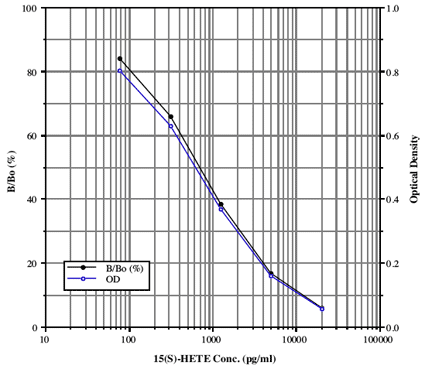- Sensitive - very low detection limit
- Easy - few reagent preparation steps save time in the lab
- Trusted - highly cited in peer-reviewed publications
- Reliable - reproducible results day-after-day and lot-after-lot
The 15(S)-HETE EIA kit is a colorimetric competitive enzyme immunoassay kit with results overnight + 1 hour. Absorbance is read at 405 nm.
Please mouse over
Product Details
| Alternative Name: | 15(S)-hydroperoxy tetraenoic eicosatetraenoic acid |
| |
| Sensitivity: | 69.21 pg/ml (range 78.1 - 20,000 pg/ml) |
| |
| Assay Time: | Overnight + 1 hour |
| |
| Applications: | ELISA, Colorimetric detection
|
| |
| Application Notes: | For the quantitative determination of 15(S)-HETE in culture supernatants, plasma, serum, and urine from any species. |
| |
| Wavelength: | 405 nm |
| |
| Species reactivity: | Species independent
|
| |
| Use/Stability: | Store all components at +4°C, except standard and conjugate at -20°C. |
| |
| Shipping: | Blue Ice |
| |
| Contents: | GxR IgG Microtiter plate, Conjugate, Antibody, Assay buffer, Wash buffer concentrate, Standard, pNpp Substrate, Stop solution |
| |
| Scientific Background: | HETEs are byproducts generated by the metabolism of arachidonic acid by lipoxygenases. 12(S)-HETE is the stereospecific hydroxy product from the reduction of 12(S)-hydroperoxy tetraenoic eicosatetraenoic acid [12(S)-HpETE], which itself is a 12-lipoxygenase metabolite of arachidonic acid. 12(S)-HETE is chemotactic and chemokinetic for polymorphonuclear leukocytes and vascular smooth muscle cells. It also acts as a second messenger in angiotensin-II induced aldosterone production. 15-hydroxyeicosatetraenoic acid [15(S)-HETE] is the major hydroxy derivative of arachidonic acid when acted upon by 15-lipoxygenase. It is also the primary monohydroxy acid synthesized by the lipoxygenase activity of Cyclooxygenase-1 upon linoleic acid. 15(S)-HETE acts as a paracrine regulator of smooth muscle and lung neutrophil recruitment, and elevated levels of 15(S)-HETE are associated with asthma, rhinitis, chronic paranasal sinusitis and rheumatoid arthritis. |
| |
| Regulatory Status: | RUO - Research Use Only |
| |
| Compatibility: | This product is compatible with the Absorbance 96 Plate Reader.
 |
| |
Product Literature References
ACSL4 and the lipoxygenases 15/15B are pivotal for ferroptosis induced by iron and PUFA dyshomeostasis in dopaminergic neurons: H. Bouchaoui, et al.; Free Radic. Biol. Med.
195, 145 (2023),
Abstract;
Development of heart failure with preserved ejection fraction in type 2 diabetic mice is ameliorated by preserving vascular function: M. Otto, et al.; Life Sci.
284, 119925 (2021),
Abstract;
12(S)-HETE Mediates Diabetes Induced Endothelial Dysfunction by Activating Intracellular Endothelial Cell TRPV1: M. Otto, et al.; J. Clin. Invest.
130, 4999 (2020),
Abstract;
Full Text
Arachidonate 12-Lipoxygenase and 12-Hydroxyeicosatetraenoic acid contribute to stromal aging-induced progression of pancreatic cancer: E.H. Sarsour, et al.; J. Biol. Chem.
295, 6946 (2020),
Abstract;
Full Text
Early proteome shift and serum bioactivity precede diesel exhaust-induced impairment of cardiovascular recovery in spontaneously hypertensive rats: L.C. Thompson, et al.; Sci. Rep.
9, 6885 (2019),
Application(s): ELISA using rat serum,
Abstract;
Full Text
Programming of macrophages by UV-irradiated apoptotic cancer cells inhibits cancer progression and lung metastasis: Y.B. Kim, et al.; Cell. Mol. Immunol.
16, 851 (2019),
Application(s): ELISA using culture supernatants,
Abstract;
Mice lacking L-12/15-lipoxygenase show increased mortality during kindling despite demonstrating resistance to epileptogenesis: M.A. Kanzler, et al.; Epilepsia Open
3, 255 (2018),
Application(s): Cell Culture Supernatant,
Abstract;
Full Text
The atheroprotective role of lipoxin A4 prevents oxLDL-induced apoptotic signaling in macrophages via JNK pathway: J. Mai, et al.; Atherosclerosis
278, 259 (2018),
Application(s): ELISA using rabbit artery samples,
Abstract;
Proliferation and differentiation of adipose tissue in prolonged lean and obese critically ill patients: C. Goosens, et al.; Intensive Care Med. Exp.
5, 16 (2017),
Abstract;
Full Text
12/15-Lipoxygenase metabolites of arachidonic acid activate PPARγ: a possible neuroprotective effect in ischemic brain: L. Sun, et al.; J. Lipid. Res.
56, 502 (2015),
Application(s): ELISA,
Abstract;
Full Text
Effect of a low-fat fish oil diet on proinflammatory eicosanoids and cell-cycle progression score in men undergoing radical prostatectomy: C. Gallet, et al.; Cancer Prev. Res. (Phila)
7, 97 (2014),
Abstract;
12/15-lipoxygenase contributes to platelet-derived growth factor-induced activation of signal transducer and activator of transcription 3: T. Blazevic, et al.; J. Biol. Chem.
288, 35592 (2013),
Application(s): ELISA using culture supernatants,
Abstract;
Full Text
A novel pathway involving progesterone receptor, 12/15-lipoxygenase-derived eicosanoids, and peroxisome proliferator-activated receptor gamma regulates implantation in mice: Q. Li, et al.; J. Biol. Chem.
279, 11570 (2004),
Sample(s) tested: Mouse uteri homogenates.,
Abstract;
15-Lipoxygenase-1 mediates cyclooxygenase-2 inhibitor-induced apoptosis in gastric cancer: J. Wu, et al.; Carcinogenesis
24, 243 (2003),
Sample(s) tested: AGS and MGC803 cells,
Abstract;
Differential effects of aspirin and misoprostol on 15-hydroxyeicosatetraenoic acid generation by leukocytes from aspirin-sensitive asthmatic patients: M.L. Kowalski, et al.; J. Allergy Clin. Immunol.
112, 505 (2003),
Sample(s) tested: Human leukocyte supernatant,
Abstract;
Nonsteroidal anti-inflammatory drugs induce apoptosis in esophageal cancer cells by restoring 15-lipoxygenase-1 expression: I. Shureiqi, et al.; Cancer Res.
61, 4879 (2001),
Sample(s) tested: Human esophageal cancer cells,
Abstract;
15(S)-HETE modulates LTB(4) production and neutrophil chemotaxis in chronic bronchitis: M. Profita, et al.; Am. J. Physiol. Cell Physiol.
279, C1249 (2000),
Sample(s) tested: Human induced sputum,
Abstract;
15-Lipoxygenase-1 mediates nonsteroidal anti-inflammatory drug-induced apoptosis independently of cyclooxygenase-2 in colon cancer cells: I. Shureiqi, et al.; Cancer Res.
60, 6846 (2000),
Sample(s) tested: Colorectal cancer cells (DLD-1),
Abstract;
Differential metabolism of arachidonic acid in nasal polyp epithelial cells cultured from aspirin-sensitive and aspirin-tolerant patients: M.L. Kowalski, et al.; Am. J. Respir. Crit. Care Med.
161, 391 (2000),
Sample(s) tested: Human nasal polyp epithelial cells,
Abstract;
Normal high density lipoprotein inhibits three steps in the formation of mildly oxidized low density lipoprotein: step 1: M. Navab, et al.; J. Lipid Res.
41, 1481 (2000),
Sample(s) tested: Human low density lipoprotein from serum,
Abstract;
Hepatocytes are a rich source of novel aspirin-triggered 15-epi-lipoxin A(4): E. Titos, et al.; Am. J. Physiol. Cell Physiol.
277, C870 (1999),
Sample(s) tested: Rat hepatocytes and CC-1 cells supernatant,
Abstract;
Changes in expression of 15-lipoxygenase and prostaglandin-H synthase during differentiation of human tracheobronchial epithelial cells: E.M. Hill, et al.; Am. J. Respir. Cell Mol. Biol.
18, 662 (1998),
Sample(s) tested: Human tracheobronchial epithelial cells,
Abstract;
General Literature References
Oral green tea catechin metabolites are incorporated into human skin and protect against UV radiation-induced cutaneous inflammation in association with reduced production of pro-inflammatory eicosanoid 12-hydroxyeicosatetraenoic acid: L.E. Rhodes, et al.; Br. J. Nutr.
28, 1 (2013),
Abstract;
Related Products














